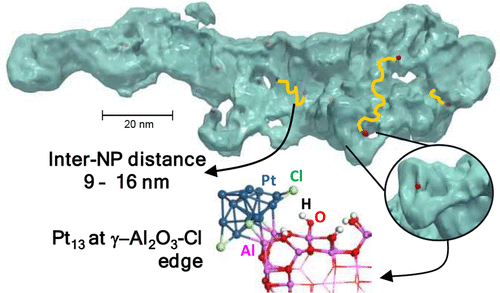当前位置:
X-MOL 学术
›
ACS Catal.
›
论文详情
Our official English website, www.x-mol.net, welcomes your feedback! (Note: you will need to create a separate account there.)
Atomic Scale Insight into the Formation, Size, and Location of Platinum Nanoparticles Supported on γ-Alumina
ACS Catalysis ( IF 12.9 ) Pub Date : 2020-03-19 , DOI: 10.1021/acscatal.0c00042 Ana T. F. Batista 1 , Walid Baaziz 2 , Anne-Lise Taleb 1 , Johan Chaniot 1, 3 , Maxime Moreaud 1, 4 , Christèle Legens 1 , Antonio Aguilar-Tapia 5 , Olivier Proux 6 , Jean-Louis Hazemann 5 , Fabrice Diehl 1 , Céline Chizallet 1 , Anne-Sophie Gay 1 , Ovidiu Ersen 2 , Pascal Raybaud 1
ACS Catalysis ( IF 12.9 ) Pub Date : 2020-03-19 , DOI: 10.1021/acscatal.0c00042 Ana T. F. Batista 1 , Walid Baaziz 2 , Anne-Lise Taleb 1 , Johan Chaniot 1, 3 , Maxime Moreaud 1, 4 , Christèle Legens 1 , Antonio Aguilar-Tapia 5 , Olivier Proux 6 , Jean-Louis Hazemann 5 , Fabrice Diehl 1 , Céline Chizallet 1 , Anne-Sophie Gay 1 , Ovidiu Ersen 2 , Pascal Raybaud 1
Affiliation

|
A clear description of the morphology and location, with respect to the support, of metallic subnanometric particles remains a current strenuous experimental challenge in numerous catalytic applications such as naphtha reforming and biomass conversion. High-resolution HAADF-STEM coupled with in situ and tomographic analyses have been undertaken on a platinum (Pt) active phase supported on chlorinated alumina (γ-Al2O3) with 0.3 and 1 wt % Pt loadings, highlighting the formation of flat nanoparticles (NPs) of 0.9 nm diameter and Pt single atoms (SAs) in the reduced state. While SAs and weakly cohesive clusters are predominantly observed in the oxide state, with a coordination sphere of Pt composed of O and Cl as revealed by EXAFS, the ratio between SAs and Pt NPs in the reduced state is found to be about 2.8. This ratio is the same for the two metal loadings: both the total numbers of NPs and SAs increase at a higher metal loading. Electron tomography reveals that the vast majority of NPs are located on the edges or defects (steps, kinks) of the γ-alumina support crystallites. DFT calculations further highlight the optimized structures of NPs located at the γ-Al2O3 (110)–(100) edge and near-edge with a stability competing with NPs located either on the (110) or on the (100) γ-Al2O3 facet. A mathematical analysis of the segmented volumes shows that the average geodesic distances between NPs is linked to Pt loading: 9 nm for 1 wt % Pt and 16 nm for 0.3 wt % Pt. Evaluation of support tortuosity descriptors using the nanoparticle positions confirms a uniform distribution on the support. A square network geometric model compatible with the geodesic distances between NPs reveals that one to five NPs can be present at the same time on each alumina crystallite depending on Pt loading.
中文翻译:

原子尺度对γ-氧化铝上负载的铂纳米粒子的形成,大小和位置的洞察
对于金属亚纳米级颗粒的形态和相对于载体的位置的清晰描述,在石脑油重整和生物质转化等众多催化应用中仍然是当前的艰巨实验挑战。高分辨率HAADF-STEM加上原位和断层分析已开展上支撑在铂(Pt)的活性相的氯化氧化铝(γ-Al系2 ö 3)具有0.3和1 wt%的Pt负载,突出了直径为0.9 nm的扁平纳米颗粒(NPs)和处于还原状态的Pt单原子(SAs)的形成。尽管在氧化态下主要观察到SAs和弱凝聚簇,但EXAFS揭示Pt由O和Cl组成的配位球,还原态下SAs和Pt NPs之比约为2.8。对于两种金属负载,此比率相同:在较高的金属负载下,NP和SA的总数均增加。电子断层扫描显示,绝大多数NP位于γ-氧化铝载体微晶的边缘或缺陷(台阶,扭结)上。DFT计算进一步突出位于所述NP的优化构的γ-Al 2 ö 3(110) - (100)边缘和近边缘与稳定性与位于无论是在(110)的NP或在(100)的γ-Al竞争2 ö 3方面。对分段体积的数学分析表明,NP之间的平均测地距离与Pt负载有关:1 wt%Pt为9 nm,0.3 wt%Pt为16 nm。使用纳米颗粒位置评估支撑物弯曲度的指标证实了支撑物上的均匀分布。与NP之间的测地距离兼容的正方形网络几何模型表明,根据Pt的负载量,每个氧化铝微晶上可以同时存在1-5个NP。
更新日期:2020-03-20
中文翻译:

原子尺度对γ-氧化铝上负载的铂纳米粒子的形成,大小和位置的洞察
对于金属亚纳米级颗粒的形态和相对于载体的位置的清晰描述,在石脑油重整和生物质转化等众多催化应用中仍然是当前的艰巨实验挑战。高分辨率HAADF-STEM加上原位和断层分析已开展上支撑在铂(Pt)的活性相的氯化氧化铝(γ-Al系2 ö 3)具有0.3和1 wt%的Pt负载,突出了直径为0.9 nm的扁平纳米颗粒(NPs)和处于还原状态的Pt单原子(SAs)的形成。尽管在氧化态下主要观察到SAs和弱凝聚簇,但EXAFS揭示Pt由O和Cl组成的配位球,还原态下SAs和Pt NPs之比约为2.8。对于两种金属负载,此比率相同:在较高的金属负载下,NP和SA的总数均增加。电子断层扫描显示,绝大多数NP位于γ-氧化铝载体微晶的边缘或缺陷(台阶,扭结)上。DFT计算进一步突出位于所述NP的优化构的γ-Al 2 ö 3(110) - (100)边缘和近边缘与稳定性与位于无论是在(110)的NP或在(100)的γ-Al竞争2 ö 3方面。对分段体积的数学分析表明,NP之间的平均测地距离与Pt负载有关:1 wt%Pt为9 nm,0.3 wt%Pt为16 nm。使用纳米颗粒位置评估支撑物弯曲度的指标证实了支撑物上的均匀分布。与NP之间的测地距离兼容的正方形网络几何模型表明,根据Pt的负载量,每个氧化铝微晶上可以同时存在1-5个NP。



























 京公网安备 11010802027423号
京公网安备 11010802027423号